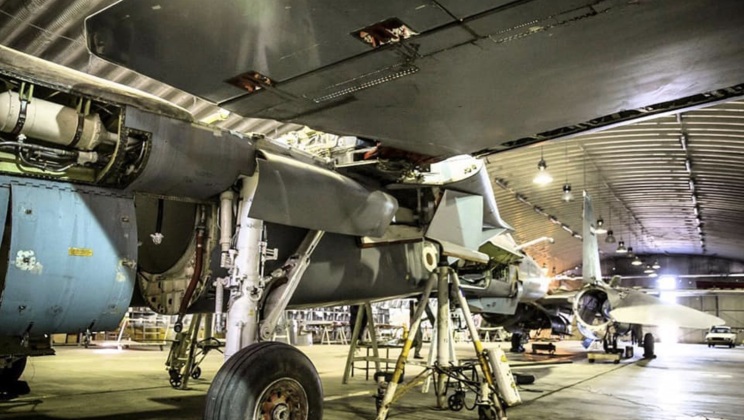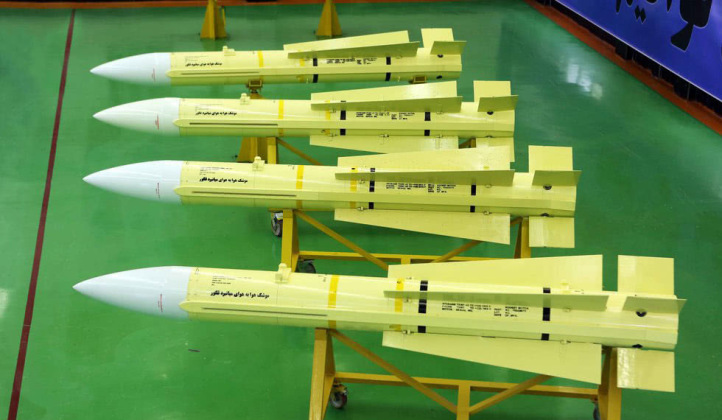During the Iran-Iraq War the most dominant aerial warfare asset and the only one from the new fourth generation of aircraft to be deployed was the Iranian F-14 Tomcat. The F-14 was not only the most advanced fighter in the conflict, but also the heaviest and by far the most costly having been designed for the U.S. Navy and far exceeding the acquisition and operational costs of the U.S. Air Force’s own top fighter the lighter F-15. Iran was the only client in the world for the F-14, acquiring 79 fighters in the mid-late 1970s and having planned to acquire 81 more before a change in government in 1979 ended prospects for a deal. F-14s destroyed more Iraqi fighters than the rest of the Iranian military combined, and they remain Iran’s most capable fighters today. The fighter’s performance was built around its very large and potent sensor suite and its use of the AIM-54 Phoenix air to air missile, a heavy weapon no other American fighter was large enough to deploy and which pioneered active radar homing technologies and had a long 190km range and a very high Mach 5 speed.

Although Iran’s fleet of U.S. made combat aircraft had been expected by Western analysts to be out of service within a decade due to shortages of parts, and this particularly applied to the F-14 which was both extremely complex and parts for which were extremely scarce internationally due to the scarcity of foreign operators, Iran able to develop a domestic industry to sustain and produce parts for them. In order to prevent the F-14s from becoming obsolete Iran would invest heavily in modernising the fighters domestically, with the aircraft receiving new cockpit displays, electronic warfare systems and other avionics improvements. The aircraft also integrated Russian R-77 air to air missiles which, unlike the American AIM-54, could be replenished and were also much lighter allowing the Tomcat to retain a good flight performance. In 2013 a never before seen yet familiar air to air missile, the Fakour-90, was displayed and bore a strong resemblance to the AIM-54. The new missile boasted several improvements over the original Phoenix missile which it was clearly based on including a superior guidance system, new electronic warfare countermeasures and an enhanced range. The new guidance system was approximately 30% smaller, and based on the reduced weight of the more modern systems and potential for added propellants the missile’s range was estimated at 220-300km. The Fakour’s guidance system was reportedly similar to that used on the Mersad surface to air missile.

The U.S. Navy retired its F-14 fighters and Phoenix Missiles in 2006, and following the end of the Cold War and the refocusing towards counterinsurgency there appeared little need to maintain air superiority fighters with such significant operational costs. The result was that the country all but abandoned long range air to air missiles capable of intercepting targets at extreme ranges, with the missile’s replacement the AIM-154 being cancelled when the Cold War ended as the challenge posed by Soviet bomber strikes on American carrier groups receded. Iran’s development of the Fakour-90 reflects continued focus on preparations for war with a near peer or superior adversary air force, be it Israel, Saudi Arabia or the United States, has led it to obtain the capability to engage all Western made aircraft well beyond range of retaliation with its F-14s. The majority of U.S. fighters including the F-18E, F-15 and F-16 rely on the AIM-120C missiles with a range of around 105km – less than half that of the Fakour-90 – while the new AIM-120D equipping 4+ and fifth generation units have a range estimated at 160-180km. This is not because the Iranian missile is more advanced, but because it is so much larger, although the U.S. had begun development of its own very long range air to air missile to equip its new F-15EX fighters which should surpass the Fakour-90 in performance.

With vast majority of Iran’s combat fleet made up of heavily dated Vietnam War era platforms such as the F-4 Phantom, the country’s’ fleet of approximately 40 operational F-14s may well be its only platform capable of operating offensively in an air to air role. Flying safely over Iranian airspace, the Tomcats will be able to target and destroy hostile aircraft flying over Abu Dhabi, and at a stretch possibly over Riyadh if operating over the gulf waters, using the Fakour-90’s long range. Should Iranian aircraft ever operate over Iraqi airspace, something which can hardly be ruled out based on the Arab state’s heavily reliance on and extensive military cooperation with its larger neighbour, Iranian Tomcats would be able to target Israeli aircraft over Tel Aviv. Israel’s F-15 fighters, with a retaliation range of just 105km and no AESA radars or AIM-120D missiles would be unable to respond without leaving their airspace.

The Fakour-90 is hardly the world’s top missile of its kind, with the Russian R-37 and particularly the Chinese PL-XX far surpassing its performance, but for a country with a relatively small and new military aviation sector it does represent a formidable asset and a low cost means of modernising the country’s air fleet. The U.S. for its part has means to potentially tackle such missiles by relying on stealth fighters such as the F-22 to close the range gap with the F-14 and engage with the shorter ranged AIM-120D missiles before the F-14 can form a target lock, although there are significant risks with this approach and America’s regional allies lack access to comparable aircraft. With Iran’s lack of supporting electronic attack aircraft or airborne early warning and control aircraft placing its fighter units, the F-14 alone will likely struggle to engage the larger fleets of heavyweight aircraft deployed around its borders, although if operating from within Iranian airspace with support from ground based radars and air defences the fighter has the potential to seriously complicate offensives against Iran.
